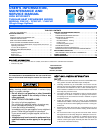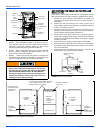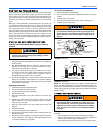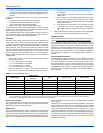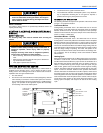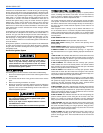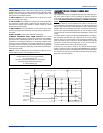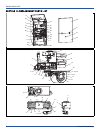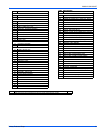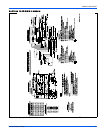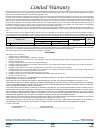
269434-UUM-A-0407
4 Unitary Products Group
• Check for dirt or lint on any surfaces or on components. Do not try
to clean any of the surfaces or components. Cleaning of the fur-
nace and its components must be done by a qualified service pro-
fessional.
If, during the inspection of your furnace, you find any of the following
conditions:
• Excessive amounts of dust and lint on components.
• Damaged or deteriorated components or surfaces.
• Leaks or blockage in the vent pipe passages.
• Water on any surface inside or outside of the furnace.
Do not operate the furnace, call a certified dealer / servicing contractor
to check and / or clean your furnace, or for more information if you have
questions about the operation of your furnace.
If all components appear to be in good operating condition, replace the
front panels. Turn ON the gas and electrical power supplies to the fur-
nace, and set thermostat to the desired temperature.
Air Filters
Dirty filters greatly restrict the flow of air and may cause damage to the
moving parts of the furnace. If the filters become clogged the heat
exchangers and blower motor could overheat resulting in a potentially
dangerous situation. The filters should be checked every 3 months. On
new construction, check the filters every week for the first four weeks
and every three weeks after that, especially if the indoor fan is running
continuously. When replacing the filter(s) you must use filters that are
the same size as those recommended in Table 1. Use the following pro-
cedure to determine the filter size. Never operate your furnace without a
suitable air filter.
1. Measure the furnace width and use that measurement to deter-
mine the cabinet width.
• A 14-1/2” wide cabinet is a “A” cabinet.
• A 17-1/2” wide cabinet is a “B” cabinet.
• A 21” wide cabinet is a “C” cabinet.
• A 24-1/2” wide cabinet is a “D” cabinet.
2. Locate the cabinet size on Table 1 then determine whether you
have a bottom or side return air duct using the following method.
a. If the return air filter is on the left or right side of the furnace it
is a side return
b. If the air filter is on the bottom of the furnace then you have a
bottom return.
C. If the air filters are on the bottom and the side of the furnace
then you have a bottom and side return. You must replace
both air filters. Table 1 will indicate 2 filters by using brackets
with the number two (2).
D. If the air filters are on both sides of the furnace then you have
a two sided return. You must replace both air filters. Table 1
will indicate 2 filters by using brackets with the number two
(2).
3. After you determine the cabinet size and what return configuration
you have, look up the recommended filter size from Table 1.
Replacing Filters
Filters used with this furnace must be installed external to the furnace
casing. DO NOT attempt to install filters inside the furnace cabinet.
Some installations may have the air filter in a rack attached to the cas-
ing of the furnace or placed in the return air duct. If the filter location or
replacement process is not obvious, contact your installer or service
technician for assistance. Replace throw away filter(s) with the same
size new filter(s). Throw away filter(s) may be replaced with cleanable
filter(s) at this time. Cleanable filter(s) may be cleaned as described in
the manufacturer instructions or as described below and then re-
installed.
Externally Mounted Air Filters
Some installations may have the air filter in a rack attached to the cas-
ing of the furnace or placed in the return air duct. You can gain access
to the filter by pulling on the door or unscrewing the retaining screw,
then slide the filter(s) out of its channel. Replace throw away filter(s)
with the same size new filter(s). Throw away filter(s) may be replaced
with cleanable filter(s) at this time. Cleanable filter(s) may be cleaned as
described in the manufacturer instructions or as described below and
then re-installed.
NOTES:
1. Air velocity through throwaway type filters may not exceed 300 feet per minute (91.4 m/min). All velocities over this require the use of high velocity filters.
2. Air flows above 1800 CFM require either return from two sides or one side plus bottom.
How to Clean your Filter
High-velocity filters may be cleaned with a vacuum cleaner or washed
with a garden hose. Be sure to shake off excess water and allow filter to
completely dry before re-installing the filter.
Blower Care
Even with good filters properly in place, blower wheels and motors will
become dust laden after long months of operation. The entire blower
assembly should be inspected annually. If the motor and wheel are
heavily coated with dust, they can be brushed and cleaned with a vac-
uum cleaner. If the blower cannot be properly cleaned without removing
it from the furnace, then this service must be performed by a qualified
service agency.
The blower can be serviced/removed through the blower access panel
on the inside of the furnace. If there is a combustion air pipe installed
inside the furnace, it may have to be removed to access the blower
access panel. After the combustion air pipe is removed, it is easy to
remove the inside blower access panel by removing the screws of the
access panel. Blower is now ready to be serviced through the opening.
If the blower has to be removed through the inside blower access panel,
then the top and bottom angles will have to be removed to slide the
blower out of the furnace.
TABLE 1:
Recommended Filter Sizes
Input/Output
BTU/H (kW)
Nominal CFM
(m
3
/min)
Cabinet
Size
Side Return
Filter in. (cm)
Bottom Return
Filter in. (cm)
40 (11.7) 1200 (34) A 16 x 25 (41 x 64) 14 x 25 (36 x 64)
60 (17.6) 1200 (34) B 16 x 25 (41 x 64) 16 x 25 (41 x 64)
80 (23.4) 1200 (34) B 16 x 25 (41 x 64) 16 x 25 (41 x 64)
80 (23.4) 2000 (57) C 16 x 25 (41 x 64) 20 x 25 (51 x 64)
100 (29.3) 2000 (57) C 16 x 25 (41 x 64) 20 x 25 (51 x 64)
120 (35.1) 2000 (57) D (2) 16 x 25 (2) (41 x 64) 22 x 25 (56 x 64)
135 (39.6) 2000 (57) D (2) 16 x 25 (2) (41 x 64) 22 x 25 (56 x 64)



